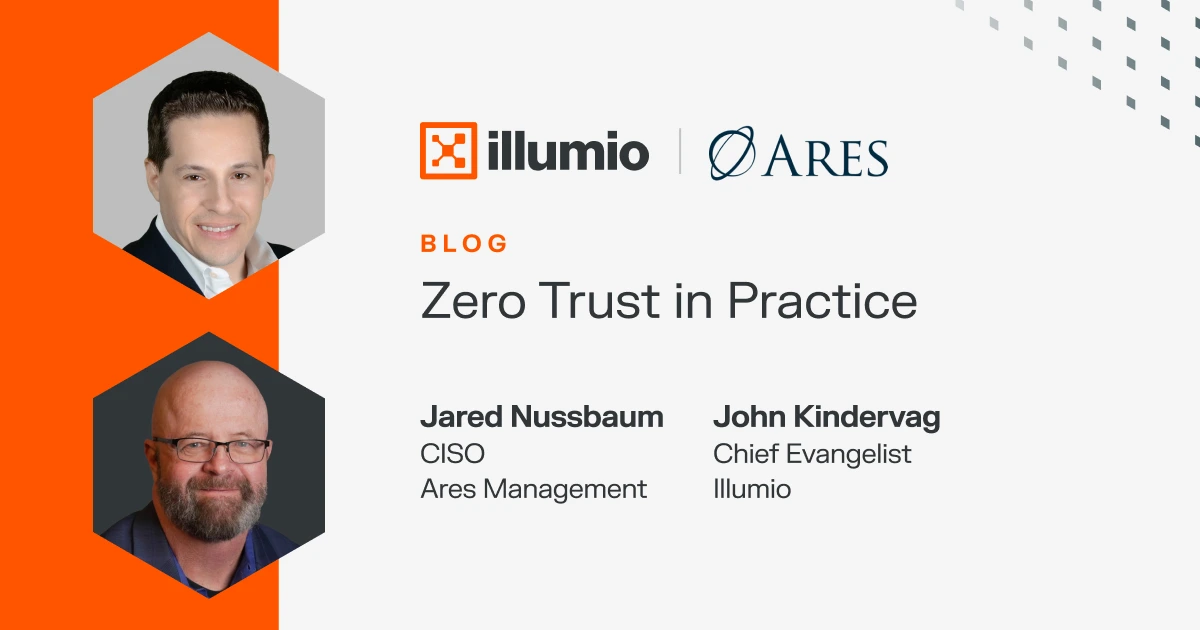What U.S. Army and Navy SEAL Strategies Can Teach You About Zero Trust
Two leaders. Two very different paths to service.
Clint Bruce was a standout football player at the U.S. Naval Academy with a shot at the NFL — until he walked away to become a Navy SEAL, trading stadium lights for special operations.
General Viet Xuan Luong fled Saigon as a child refugee, later becoming the first Vietnamese-born general in U.S. Army history.
What do they both share? A mindset forged in high-stakes environments where trust, clarity, and preparation are everything. This shaped the entire conversation in our recent LinkedIn Live, Zero Trust, Terrain, and Holding the High Ground.
In the session, Bruce and General Luong joined Zero Trust creator and Illumio Chief Evangelist John Kindervag to explore how military principles like terrain, trust, and discipline offer a roadmap for stronger cybersecurity strategies. It was a discussion about leadership, mindset, and mission that bridges the battlefield and the boardroom.
Why terrain and trust are everything
For Bruce, terrain is geography just as much as it’s the foundation of every strategic decision.
“You don’t conduct operations without a terrain model,” he explained. “Cyber is terrain, and the defender has to understand it better than the adversary.”
In both the battlefield and the data center, the lesson is the same. You can’t protect what you don’t understand. Knowing your environment — your terrain — gives you the upper hand. Without it, you’re fighting blind.
You don’t conduct operations without a terrain model. Cyber is terrain, and the defender has to understand it better than the adversary.
Now leading the HoldFast Foundation and mentoring leaders across industries, Bruce shared how trust is earned, never assumed.
“In my world, trust isn’t given. It’s built,” Bruce said. “You earn it through clarity, consistency, and courage.”
General Luong echoed this approach from a leadership perspective. In his military career, clarity was essential for mission success.
“As a commander, I couldn’t assume everyone on the team had perfect information,” he said. “I had to create clarity and build trust through repetition, structure, and communication.”
Just as elite teams validate and verify everything in a high-stakes mission, Zero Trust assumes nothing about users, devices, or applications without clear, continuous validation.
Because in both war and cybersecurity, the cost of assuming trust can be catastrophic.
Cybersecurity’s terrain gap and how Zero Trust fixes it
Kindervag explained how traditional cybersecurity lacks one of the most essential concepts from military strategy: a clear model of terrain.
“If I asked most organizations to draw their network terrain, they couldn’t,” he said. “You wouldn’t go into combat blind, but that’s how most of us operate in cybersecurity.”
To drive the point home, Kindervag showed an image from President Obama’s inauguration where he was flanked by Secret Service agents in a layered, visual perimeter.

The agents knew three things:
- Who the President was
- Where he was
- How to segment and protect him from potential threats
“That’s Zero Trust in the real world,” Kindervag said. “It’s not about building taller walls. It’s about understanding who and what you’re protecting, where it lives, and how it interacts with everything around it.”
Visibility is the new high ground
One of the strongest metaphors of the day came from Bruce.
“In special operations, the first thing you do is secure the high ground,” he said. “If you don’t, your adversary will.”
That “high ground” in cybersecurity is visibility. Without it, security teams are left reacting to threats instead of proactively containing them.
“You can’t defend what you can’t see,” Kindervag reiterated. “Zero Trust starts with visibility — understanding your terrain.”
Luong agreed. “The best commanders I knew weren’t the ones with the loudest voices,” he said. “They were the ones who knew their terrain and could make decisions in the fog of war.”
He added that the same holds true in cybersecurity leadership: “Visibility and understanding are force multipliers. You win when you can make fast, clear decisions based on reality, not assumption.”
From physical battlefields to digital ones, the mission is the same
Throughout the session, the thread that tied everything together was leadership. Not just the title or the rank but the mindset.
“You don’t rise to the occasion,” Bruce said. “You default to your level of preparation.”
Zero Trust offers that preparation. It gives organizations a way to see clearly, respond decisively, and control what happens inside their environment, even after an attacker gets in.
You don’t rise to the occasion. You default to your level of preparation.
That’s what Illumio focuses on every day. In the Post-Breach Era, it’s not enough to try to keep threats out. You have to be ready to contain them the moment they break through.
Ready to rethink your high ground?
If you’re a cybersecurity leader, your job isn’t just to buy tools and block attacks. It’s to understand your terrain, build clarity across your environment, and adopt a framework that assumes breach and enables control.
And as Kindervag emphasized, Zero Trust is not a product. It's a mindset shift.
Just like in combat, that shift starts with understanding the mission and holding your ground, no matter what comes your way.
Watch the full LinkedIn Live to learn how visibility, clarity, and Zero Trust mindset can reshape your cyber strategy.
.png)


.webp)


.webp)